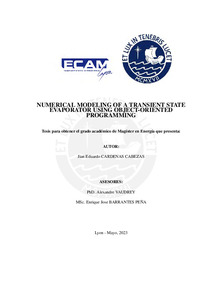| dc.contributor.advisor | Barrantes Peña, Enrique José | |
| dc.contributor.author | Cárdenas Cabezas, Jian Eduardo | |
| dc.date.accessioned | 2023-06-20T15:11:16Z | |
| dc.date.available | 2023-06-20T15:11:16Z | |
| dc.date.created | 2023 | |
| dc.date.issued | 2023-06-20 | |
| dc.identifier.uri | http://hdl.handle.net/20.500.12404/25231 | |
| dc.description.abstract | This work presents the dynamic modeling of a refrigeration machine evaporator that uses CO2
(R744) as refrigerant fluid, for the cooling down of a liquid water stream, as required for instance
by buildings air handling units. The main goal of such a work is to accurately model the
transient evolution of the evaporator outlet superheat, which is one of the main parameters to
control, due to its importance in refrigeration systems. A high value of superheat temperature
reduces the performance of the system, while a low or null value can generate the suction of
liquid which damages the compressor.
The theory of moving boundaries [19] with grouped parameters has been used for so. This
method allows a precise resolution with a low numerical weight. In this method, the evaporator
is divided into only two regions: the two phase region and superheated steam region, in which
the energy conservation and mass conservation equations are solved. By using only two control
volumes, the number of equations to be solved is smaller, thus reducing the calculation time.
The ultimate aim of this work is to serve as a mathematical model usable for the design of
efficient refrigeration system controllers, which are one of the most practical ways to improve
the performance of these machines.
The results of a numerical analysis and of a sensitivity analysis, regarding to the influence of
the heat convection coefficient of the two phase region, are also presented. For this sensitivity
analysis, the maximum and minimum values available in the literature, see reference [7], have
been used. According to this study, the convective coefficient ofCO2 varies from 8000 to 12000
W ·m−2 ·K−1.
From this sensitivity analysis, it is observed that, despite the previously mentioned uncertainty
about the convective coefficient value, the latter is not influential on the rest of the calculations
and on parameters such as internal pressure, length of the two-phase lengths or superheat
value. This is due to the fact that the thermal resistance of the liquid hot fluid is much higher
than the cold fluid in the phase change region, the global heat transfer coefficient is thus more
influenced by the hot fluid thermal resistance.
A maximum error of 3 percent is finally estimated in the determination of the transient
superheat temperature. | es_ES |
| dc.language.iso | eng | es_ES |
| dc.publisher | Pontificia Universidad Católica del Perú | es_ES |
| dc.rights | info:eu-repo/semantics/openAccess | es_ES |
| dc.rights.uri | http://creativecommons.org/licenses/by-nc-sa/2.5/pe/ | * |
| dc.subject | Refrigeración | es_ES |
| dc.subject | Control de la temperatura | es_ES |
| dc.subject | Controladores programables--Diseño y construcción | es_ES |
| dc.title | Numerical modeling of a transient state evaporator using object-oriented programming | es_ES |
| dc.type | info:eu-repo/semantics/masterThesis | es_ES |
| thesis.degree.name | Maestro en Energía | es_ES |
| thesis.degree.level | Maestría | es_ES |
| thesis.degree.grantor | Pontificia Universidad Católica del Perú. Escuela de Posgrado | es_ES |
| thesis.degree.discipline | Energía | es_ES |
| renati.advisor.dni | 07913376 | |
| renati.advisor.orcid | https://orcid.org/0000-0002-9037-3358 | es_ES |
| renati.author.dni | 77025959 | |
| renati.discipline | 711117 | es_ES |
| renati.juror | Jimenez Ugarte, Fernando Octavio | es_ES |
| renati.juror | Barrantes Peña, Enrique Jose | es_ES |
| renati.juror | Rojas Chavez, Freddy Jesus | es_ES |
| renati.level | https://purl.org/pe-repo/renati/level#maestro | es_ES |
| renati.type | https://purl.org/pe-repo/renati/type#tesis | es_ES |
| dc.publisher.country | PE | es_ES |
| dc.subject.ocde | https://purl.org/pe-repo/ocde/ford#2.07.03 | es_ES |







